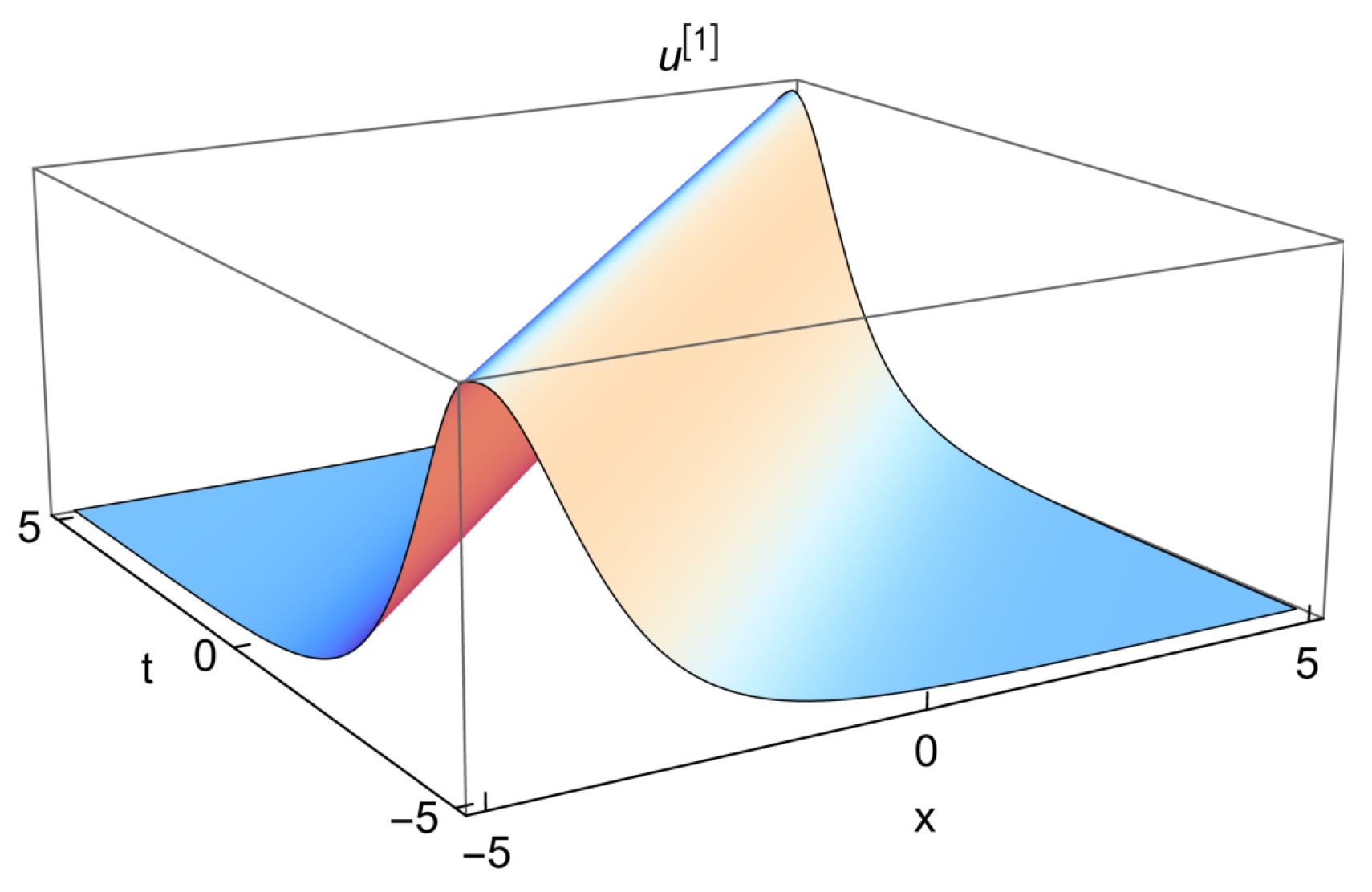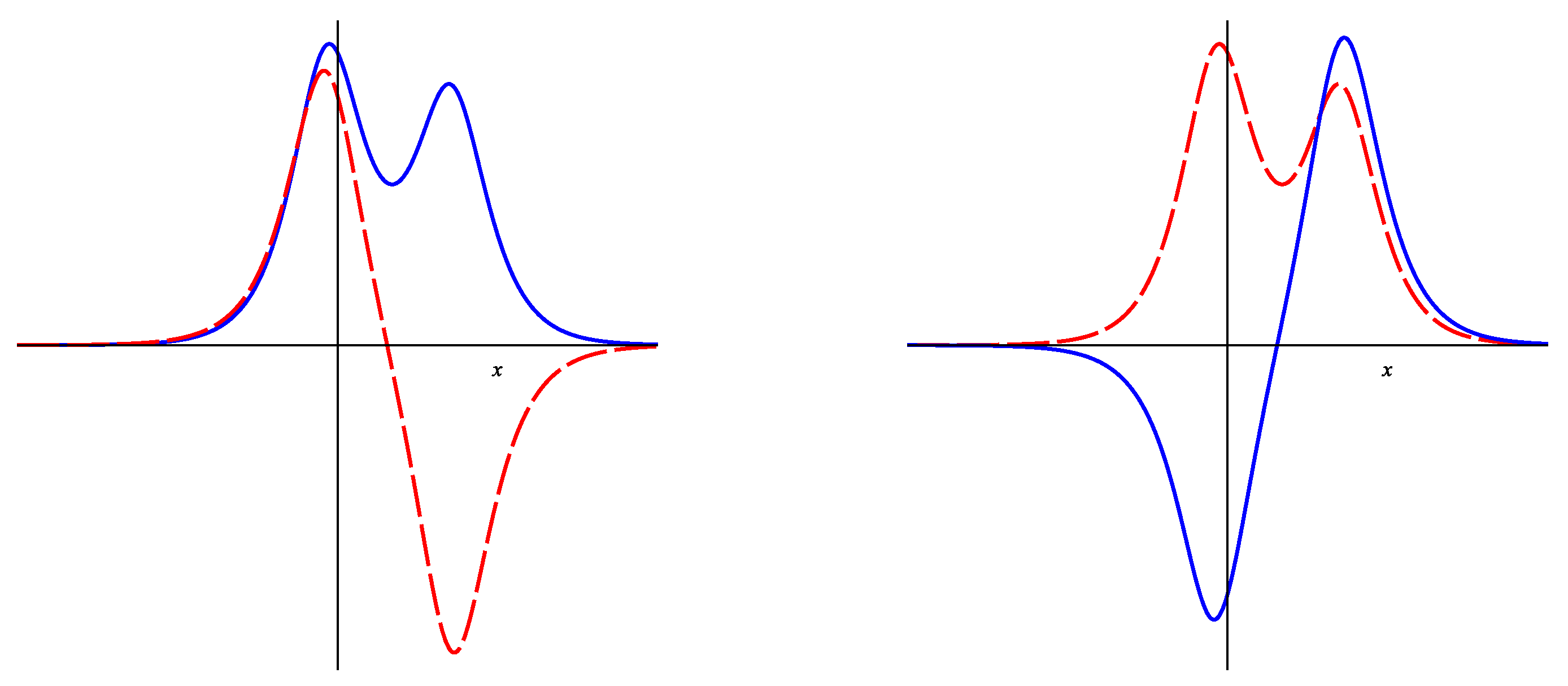A Comprehensive Study of the Complex mKdV Equation through the Singular Manifold Method
Abstract
1. Introduction
2. Generalized Complex mKdV Equation
2.1. Painlevé Property
2.2. Truncation of the Painlevé Series: Modified SMM
- Leading-order termsThe usual application of the SMM implies , and thereforeNonetheless, according to our previous discussion, this condition should be relaxed by introducing a constant such thatThis is the critical point in our modification of the SMM. As we shall see later, is just the necessary spectral parameter of the Lax pair which appears as a consequence of the generalization of the SMM.
- Expression of the fields in terms of the singular manifoldThe coefficients in in (5) yield the following expressions for the seminal solutions in terms of the singular manifoldwhere v is a useful quantity related to the singular manifold defined as
- Singular manifold equationsThe truncation of the Painlevé series implies that the singular manifold should satisfy a set of conditions named as singular manifold equations. These conditions can be obtained from the coefficients in and in (5) aswhere we have defined r as
2.3. Lax Pair
2.4. The Singular Manifold and the Eigenfunctions
2.5. Darboux Transformations
2.6. -Functions and Iterated Solutions
3. Solutions
3.1. Eigenfunctions for the Seed Solution
3.2. -Matrix
3.3. First Iterated Solution
3.4. Second Iterated Solution
4. Conclusions
Author Contributions
Funding
Data Availability Statement
Acknowledgments
Conflicts of Interest
Appendix A. Modification of the SMM
References
- Ablowitz, M.J.; Clarkson, P.A. Solitons, Nonlinear Evolution Equations and Inverse Scattering; London Mathematical Society, Lecture Notes Series 149; Cambridge University Press: Cambridge, UK, 1991. [Google Scholar]
- Weiss, J. The Painlevé property for partial differential equations. II: Bäcklund transformation, Lax pairs, and the Schwarzian derivative. J. Math. Phys. 1983, 24, 1405–1413. [Google Scholar] [CrossRef]
- Ablowitz, M.J.; Ramani, A.; Segur, H. Nonlinear evolution equations and ordinary differential equations of Painlevé type. Lett. Nuovo Cim. 1978, 23, 333–338. [Google Scholar] [CrossRef]
- Weiss, J.; Tabor, M.; Carnevale, G. The Painlevé property for partial differential equations. J. Math. Phys. 1983, 24, 522–526. [Google Scholar] [CrossRef]
- Estévez, P.G.; Conde, E.; Gordoa, P.R. Unified approach to Miura, Bäcklund and Darboux transformations for Nonlinear Partial Differential Equations. J. Nonlinear Math. Phys. 1998, 5, 82–114. [Google Scholar] [CrossRef]
- Camassa, R.; Holm, D.D. An integrable shallow water equation with peaked solitons. Phys. Rev. Lett. 1993, 71, 1661–1664. [Google Scholar] [CrossRef] [PubMed]
- Hone, A.N.W. Reciprocal link for 2+1-dimensional extensions of shallow water equations. Appl. Math. Lett. 2000, 13, 37–42. [Google Scholar] [CrossRef]
- Estévez, P.G.; Prada, J. Hodograph Transformations for a Camassa–Holm hierarchy in 2 + 1 dimensions. J. Phys. A Math. Gen. 2005, 38, 1287–1297. [Google Scholar] [CrossRef]
- Rogers, C.; Shadwick, W.F. Bäcklund Transformations and Their Applications; Mathematics in Science and Engineering; Academic Press: Cambridge, MA, USA, 1982; Volume 161. [Google Scholar]
- Estévez, P.G.; Gordoa, P.R.; Martinez-Alonso, L.; Medina-Reus, E. Modified singular manifold expansion: Application to the Boussinesq and Mikhailov-Shabat systems. J. Phys. A Math. Gen. 1993, 26, 1915–1925. [Google Scholar] [CrossRef]
- Flaschka, H.; Newell, A.; Tabor, M. What Is Integrability? Springer Series in Nonlinear Dynamics’; Springer: Berlin/Heidelberg, Germany, 1991. [Google Scholar]
- Estévez, P.G.; Leble, S. A wave equation in 2 + 1: Painlevé analysis and solutions. Inverse Probl. 1995, 11, 925–937. [Google Scholar] [CrossRef]
- Albares, P.; Estévez, P.G.; Radha, R.; Saranya, R. Lumps and rogue waves of generalized Nizhnik–Novikov–Veselov equation. Nonlinear Dyn. 2017, 90, 2305–2315. [Google Scholar] [CrossRef]
- Li, Y.; Li, R.; Xue, B.; Geng, X. A generalized complex mKdV equation: Darboux transformations and explicit solutions. Wave Motion 2020, 98, 102639. [Google Scholar] [CrossRef]
- Anco, S.C.; Mohiuddin, M.; Wolf, T. Traveling waves and conservation laws for complex mKdV-type equations. Appl. Math. Comput. 2012, 219, 679–698. [Google Scholar] [CrossRef]
- Hirota, R. Direct Method in Soliton Theory; Cambridge University Press: Cambridge, UK, 2004. [Google Scholar]
- Matveev, V.B.; Salle, M.A. Darboux Transformations and Solitons; Springer: Berlin/Heidelberg, Germany, 1991. [Google Scholar]
- Cieslinski, J.; Goldstein, P.; Sym, A. Isothermic surfaces in E3 as soliton surfaces. Phys. Lett. A 1995, 205, 37–43. [Google Scholar] [CrossRef]
- Konopelchenko, B.; Stramp, W. On the structure and properties of the singularity manifold equations of the KP hierarchy. J. Math. Phys. 1991, 32, 40–49. [Google Scholar] [CrossRef]
- Hirota, R. Reduction of soliton equations in bilinear form. Phys. D 1986, 18, 161–170. [Google Scholar] [CrossRef]



Disclaimer/Publisher’s Note: The statements, opinions and data contained in all publications are solely those of the individual author(s) and contributor(s) and not of MDPI and/or the editor(s). MDPI and/or the editor(s) disclaim responsibility for any injury to people or property resulting from any ideas, methods, instructions or products referred to in the content. |
© 2023 by the authors. Licensee MDPI, Basel, Switzerland. This article is an open access article distributed under the terms and conditions of the Creative Commons Attribution (CC BY) license (https://creativecommons.org/licenses/by/4.0/).
Share and Cite
Albares, P.; Estévez, P.G. A Comprehensive Study of the Complex mKdV Equation through the Singular Manifold Method. Mathematics 2023, 11, 859. https://doi.org/10.3390/math11040859
Albares P, Estévez PG. A Comprehensive Study of the Complex mKdV Equation through the Singular Manifold Method. Mathematics. 2023; 11(4):859. https://doi.org/10.3390/math11040859
Chicago/Turabian StyleAlbares, Paz, and Pilar G. Estévez. 2023. "A Comprehensive Study of the Complex mKdV Equation through the Singular Manifold Method" Mathematics 11, no. 4: 859. https://doi.org/10.3390/math11040859
APA StyleAlbares, P., & Estévez, P. G. (2023). A Comprehensive Study of the Complex mKdV Equation through the Singular Manifold Method. Mathematics, 11(4), 859. https://doi.org/10.3390/math11040859







